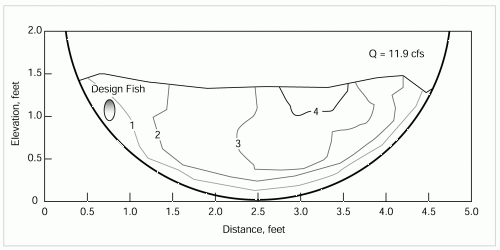Occupied Velocity |
FishXing, like other culvert models, calculates the average cross sectional water velocities. However, in many instances fish take advantage of slower velocities along the culver walls and bottom. Referred to as the occupied velocity, they are often only 10% to 50% of the average water velocity (Powers, 1997).
To account for slower velocities, FishXing offers the option of applying Velocity reduction factors (ratio of occupied velocity to average cross sectional velocity, Kocc) to the inlet zone, outlet zone, and barrel of the culvert. The use of velocity reduction factors assumes the area of reduced velocity is continuous throughout the entire zone.
Using Velocity Reduction Factors to account for occupied velocity is generally only applied to smaller fish, which have been observed using the slower water found adjacent to the larger corrugation of metal pipes.

Above is a map of water velocities in the inlet zone of a 5-foot diameter culvert. The average velocity is approximately 3.3 ft/s. Notice that smaller sized fish may be able to swim through a region of lower velocities near the culvert wall. The water velocity within this region is often referred to as the occupied velocity (Vocc).
In this example Vocc = 1.5 ft/s and Vave = 3.3 ft/s.
Kocc = Vocc/Vave = 0.45
Behlke et al. (1991) has reported velocity reduction factors ranging from 0.4 to 0.8 for juvenile salmonids and suggests the following velocity reduction factors for arctic grayling:
Inlet: Kocc = 0.8
Barrel: Kocc = 0.6
Outlet: Kocc = 0.8
Use caution when applying velocity reduction factors. These factors vary substantially and are influenced by many factors, such as the shape and roughness of the culvert, the culvert alignment with the upstream channel, outlet conditions, and the size of the fish.
Various hydraulic situations can eliminate the existence of a continuous path of lower velocities. Also, larger fish will not be able to avoid the regions of higher velocities due to there increased body size, making reduction factors inappropriate to use.
See also: Inlet, Barrel and Outlet Zones, Velocity Reduction Factors